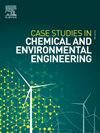Two step fractionation of oil palm empty fruit bunches integrating hydrothermal-organosolv pretreatment for enhanced lignin extraction and enzymatic hydrolysis efficiency
Q1 Environmental Science
Case Studies in Chemical and Environmental Engineering
Pub Date : 2025-08-14
DOI:10.1016/j.cscee.2025.101275
引用次数: 0
Abstract
Lignocellulosic biomass, consisting of cellulose, hemicellulose, and lignin, represents a sustainable alternative to fossil fuel resources. However, its full utilization remains unexplored, as many studies have focused on recovery only one or two components, often discharge the rest. This study aims to achieve total utilization of oil palm empty fruit bunch (OPEFB) through sequential hydrothermal-organosolv pretreatment. Hydrothermal pretreatment was first employed to extract hemicellulose, followed by organosolv pretreatment to recover lignin. The effects of temperature (175–200 °C) and solvent concentration (60–80 %) on organosolv pretreatment were evaluated focusing on lignin recovery and purity. Hydrothermal pretreatment statistically effective in enhancing lignin extraction during subsequent organosolv pretreatment resulting in increased lignin recovery and purity. The highest lignin recovery of 47.13 % with a purity of 82.95 % was obtained at 185oC and 80 % solvent concentration. Lignin characterization using FTIR, NMR, TGA, and SEM revealed structural and morphological changes induced by pretreatment steps. Subsequently, the solid residue from this process was further subjected to enzymatic hydrolysis. This resulted in a reducing sugar production of 10.21 g/L after 72 h, an improvement of more than threefold compared to solid residue from single step organosolv pretreatment. These findings highlight the efficiency of the combined pretreatment method, presenting a promising strategy for lignocellulosic biomass fractionation and biorefinery.

结合水热-有机溶剂预处理的油棕空果束两步分馏提高木质素提取和酶解效率
木质纤维素生物质,由纤维素、半纤维素和木质素组成,代表了化石燃料资源的可持续替代品。然而,它的充分利用仍未得到探索,因为许多研究只侧重于回收一种或两种成分,而往往排放其余的成分。本研究旨在通过水热-有机溶剂序贯预处理,实现油棕空果串(OPEFB)的全面利用。首先采用水热预处理提取半纤维素,然后采用有机溶剂预处理回收木质素。考察了温度(175 ~ 200℃)和溶剂浓度(60 ~ 80%)对有机溶剂预处理的影响,重点考察了木质素的回收率和纯度。水热预处理在随后的有机溶剂预处理中有效地提高木质素的提取,从而提高木质素的回收率和纯度。在温度185℃、溶剂浓度80%的条件下,木质素回收率最高,为47.13%,纯度为82.95%。利用FTIR, NMR, TGA和SEM对木质素进行表征,揭示了预处理步骤引起的结构和形态变化。随后,该过程产生的固体残渣进一步进行酶解。这导致72 h后的还原糖产量为10.21 g/L,与单步有机溶剂预处理的固体残渣相比,提高了三倍以上。这些发现突出了联合预处理方法的效率,为木质纤维素生物质分馏和生物炼制提供了一个有前途的策略。
本文章由计算机程序翻译,如有差异,请以英文原文为准。
求助全文
约1分钟内获得全文
求助全文
来源期刊

Case Studies in Chemical and Environmental Engineering
Engineering-Engineering (miscellaneous)
CiteScore
9.20
自引率
0.00%
发文量
103
审稿时长
40 days
 求助内容:
求助内容: 应助结果提醒方式:
应助结果提醒方式:


